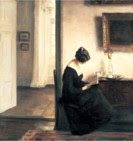I'm not sure if I should be mentioning this next fact as it could be evidence of serious derangement when it comes to book buying. I'm closing in on 1000 books on the tbr shelves (maybe I should have written 1000 books, does that make it seem less obvious?). Should I be whispering with shame or shouting with glee? I'll never be short of a book to read, that's for sure. I'm up to 968 (according to Library Thing) with several more books on the way even now. The trouble is, I'm seeing the magic 1000 books as a challenge that I must complete by the end of the year so there's definitely more glee than shame in my unrepentant attitude! I'll just mention quietly that this is only the number of physical books. The ebooks are also out of control but they're also invisible.
One book I bought recently was Summer's Day by Mary Bell. I'd been reading admiring references about it on Scott's blog, Furrowed Middlebrow, for some time now. From the original review to his search for the real identity of the author, to the most recent mention, when my resistance broke & I searched for a second hand copy (the Greyladies edition is out of print). Searching Abebooks sent me to Anglophile Books, where there were several copies of the Greyladies edition. I've been an occasional customer of Anglophile Books for some years now (unfortunately the postage costs from the US to Australia are quite high but I wasn't going to let that stop me on my quest for this book & may I say, it hasn't stopped me in the past).

Anglophile Books has the most wonderful selection of books for lovers of the middlebrow novel. Lots of my favourite authors - D E Stevenson, Dorothy L Sayers, Barbara Pym, Josephine Tey, Vera Brittain, E M Delafield - & many more. The owner, Laura, is also the convener of the D E Stevenson Yahoo group I've recently joined & she has very kindly linked to my blog on the website. If you have a look here, there are links to any books by my favourite authors that Laura has in stock. I'm not making any money out of the link, I'm just happy to point potential customers in the direction of a great secondhand bookshop.
Edited to add: Laura from Anglophile Books has created that little button which I am thrilled to say I have just successfully added to the post (thanks for the instructions, Laura). So, I'll add the button to my post if Anglophile Books has a copy of a book I'm reviewing (& gradually go back through the archive) & you'll be taken straight to the homepage if you're interested in buying a copy. I feel quite technologically competent all of a sudden!
Two themed reading weeks are coming up in the next few months that I'm very excited about. Anbolyn at Gudrun's Tights is hosting a Mary Stewart reading week from September 14th to 21st in honour of the novelist who died earlier this year. I've been planning to reread Mary Stewart ever since the last lot of reprints were published but I haven't gotten very far. However, I have lots of her novels on my shelves (no excuse there for buying more books), & I plan to read at least one for that week.
Margaret Kennedy is an author who has been on the periphery of my reading world for quite some time. I've only read The Constant Nymph but I have a couple of others on the tbr shelves & I've ordered a few of the Vintage reprints that are to be published soon. Fleur Fisher is hosting the reading week from October 6th to 12th. You'll find a comprehensive reading list on her blog. I'm leaning towards Lucy Carmichael, which seems to be a universal favourite but there are several others that look interesting. Kennedy was one of the group of novelists who went to Somerville College, Oxford in the 1920s. Vera Brittain, Winifred Holtby & Dorothy L Sayers are the most famous names but maybe Margaret Kennedy is about to join them? It won't be for want of trying if Fleur has anything to do with it.
I'm a big fan of Delphi Classics who produce complete collections of the work of out of copyright authors as very reasonably priced ebooks. They're beautifully formatted & always include some rare gems or additional material about the author. Series Five has just been announced. These titles will be published in coming months & I'm especially excited about Margaret Oliphant & Frances Hodgson Burnett. As I said above, at least they're invisible...

































